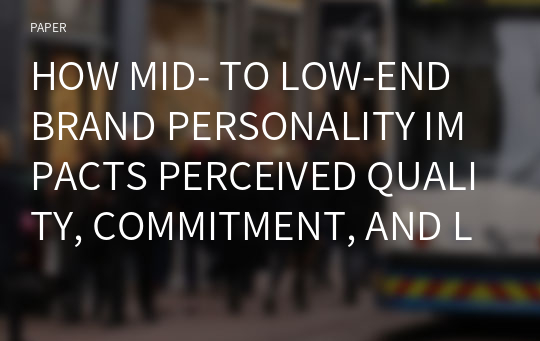HOW MID- TO LOW-END BRAND PERSONALITY IMPACTS PERCEIVED QUALITY, COMMITMENT, AND LOYALTY? COMPARING KOREAN VS. CHINESE CONSUMERS’ATTITUDES TOWARD GLOBAL AND LOCAL BRANDS
* 본 문서는 배포용으로 복사 및 편집이 불가합니다.
서지정보
ㆍ발행기관 : 글로벌지식마케팅경영학회(GFMC)
ㆍ수록지정보 : GFMC Session1
ㆍ저자명 : Su Jin Yang, Yuri Lee
ㆍ저자명 : Su Jin Yang, Yuri Lee
영어 초록
The Chinese fashion market, which has typically been dominated by luxury brands, is expanding more into mid- to low-end fashion brands including global SPA (Specialty retailer of private label apparel) brands. This change in the Chinese fashion market is due to the growth of the middle class in China. The advance of the Chinese middle class is attributed to the fact that the wages of large city workers is improving due to the development of various industries, particularly IT. Recently, the Chinese government has initiated an anti-corruption movement, which has led to the prohibition of luxury goods consumption, and so the interest of Chinese potential fashion consumers has moved to the mid-to low-end fashion products imported from developed countries. In addition, young Chinese consumers' positive attitude toward online shopping is favorable for foreign mid-to low-end brands. These changes in the tastes of Chinese fashion consumers are favorable for Korean fashion brands in particular for several reasons. First, the Korean fashion industry does not have a history of producing luxury brands, but does produce many good mid- to low-end fashion brands. In addition, Chinese tend to consider Korean fashion and food culture as more developed and preferable due to the success of the Korean wave. Lastly, it is easy for Korean practitioners to offer online shopping and customer service. The emergence of mid- to low-end fashion brands started in Korea in the late 2000s when global SPA brands entered the market. Unlike Korea's soho brands, which are based on the "No-brand" strategy, global SPA brands have actually shaken up the market by offering reasonable prices for Korean domestic brand products that are of similar quality. Since then, consumers’ willingness to pay for clothing has been reduced even further in the Korean market even though the low-growth trend in the economy has stabilized. So, it is very important to analyze and study the consumption tendency for low and mid-priced fashion brands among both Chinese and Korean consumers. The purpose of this study was to investigate how Chinese and Korean consumers perceive the personality of mid- and low-priced fashion brands and how such personality affects brand loyalty, commitment, and perceived quality. Brand personality is a vital area of research since fashion products are a type of consumer good that is consumed by users close to the body and which can express the self and the personality to others. Aaker (1997) developed a brand personality measurement scale consisting of five dimensions which many researchers have used in exploring the brand personality dimension in various industries. In the study of fashion in particular, the dimension of brand personality has been explored and its effects have been analyzed. However, most of the research has focused on luxury or high priced brands. Also, the research has not compared cultures such as China and Korea in this regard. Therefore, this study explored how Chinese and Korean consumers perceive some of the mid- to low-end priced brands originating in Europe and Korea. Also, the research examined how multiple dimensions of brand personality affected perceived quality, commitment, and brand loyalty. This study assumed that perceived quality and commitment may mediate the relationship between brand personality dimensions and loyalty. In order to conduct quantitative research, this study adopted scales from the previous literature to measure the variables used in the research model. A professional online research company conducted the survey, which was designed to be administered only to potential consumers of mid-and low-priced fashion brands who had purchased one or both European and Korean brands which were suggested in the survey. Also, gender (female), residential area (Seoul, Beijing, Shanghai), and age (21-39 years old) were controlled for. In this research, the European origin brand was the global SPA (Zara, H & M, ONLY), and there were eight Korean brands, including “Style Nanda,” which is popular in China (Refer to Table 1). The data collected on the 250 Korean and 250 Chinese participants were analyzed using statistical package SPSS 20.0. The brand personality dimension was explored using factor analysis which applied Varimax rotation based on the principle component method. As a result, even though the items included were found to be somewhat different according to the country and origin of the brand, the brand personality dimensions of the European global brands turned out to be similar and reflected “TRENDY, SINCERITY, AND COMPETENCE.” Also, Chinese consumers’ perception of brand personality in Korean brands was found to be similar to their perception of European brands. However, Korean consumers’ perception of Korean brands, which are of course their own brands, was more diverse reflecting “TRENDY, SINCERITY, COMPETENCE, AND OUTGOING.” This seems to be because Korean consumers may have had more chance to experience Korean brands either online or offline through visiting stores or being exposed to a variety of marketing communications. Thus, because there are more Korean brands than European, Korean consumers may be able to have an accurate perception of the personality of Korean brands. The conceptual model of the current research includes the relationships among multiple dimensions of brand personality in perceived quality, commitment, and loyalty. Also, the mediating effect of quality and commitment between brand personality and loyalty was examined. In order to test the hypotheses, hierarchical multiple regression using SPSS was analyzed and is described in Table 2 in relation to European brands and in Table 3 in relation to Korean brands. As expected, brand personality dimensions that were found to be a significant factor in perceived quality, commitment, and loyalty were likely to vary based on Chinese or Korean perceptions. For Korean consumers’ perception of global brands, while TRENDY was likely to be the most powerful personality dimension forming brand loyalty, its impact on loyalty seemed not to be mediated by quality but rather by commitment. Also, the influences of COMPETENCE on loyalty were mediated by quality and commitment. For Chinese consumers’ perception of global brands, the impacts of SINCERITY as well as TRENDY on loyalty were found to be mediated by quality and commitment. In addition, COMPETENCE seemed to have a rather direct impact on quality, commitment, and loyalty without a mediating effect. For local brands, Korean consumers did not seem to rely on brand personality or commitment when considering brand loyalty. Since the R2 did not improve at all with adding mediating factors such as quality and commitment, there was found to be no mediating effects in the Korean cases for local brands. In particular, while TRENDY directly impacted loyalty, OUTGOING was found to be significant only in its impact on quality. On the other hand, all three dimensions of local brand personality turned out to be significant influencers on loyalty and quality for Chinese consumers. The impact of TRENDY and COMPETENCE on loyalty seems to be mediated by quality and commitment. In this study, we found that mid- to low-end fashion brands seemed to reflect valid brand personality according to the brand’s origin (global vs. local) as well as consumers’ culture (Chinese vs. Korean). Also, the effect of brand personality dimension was different. This study contributes to the study of brand personality and the Chinese fashion market by comparing a conceptual model of the consumption behavior of Chinese and Korean consumers in relation to mid and low-priced fashion brands and brand awareness formation. In particular, the research revealed differences between Chinese and Korean consumers, suggesting different approaches for Korean fashion practitioners who are planning on entering China, which has not only a similar market to that of Korea but also one that is familiar to Korean practitioners.참고 자료
없음"GFMC Session1"의 다른 논문
 FAST AND SLOW FASHION BRANDS IN DEVELOPING SUSTAINABLE ..6페이지
FAST AND SLOW FASHION BRANDS IN DEVELOPING SUSTAINABLE ..6페이지 “WHAT IF A CELEBRITY AND A BRAND CO-CREATE A NEW COLLEC..7페이지
“WHAT IF A CELEBRITY AND A BRAND CO-CREATE A NEW COLLEC..7페이지 THE INSTAGRAM’S STRATEGY IN ENGAGING THE CUSTOMER’S LOY..3페이지
THE INSTAGRAM’S STRATEGY IN ENGAGING THE CUSTOMER’S LOY..3페이지 THE PARTICULARITIES OF NEW PRODUCT DEVELOPMENT IN THE T..5페이지
THE PARTICULARITIES OF NEW PRODUCT DEVELOPMENT IN THE T..5페이지 THE LONE CHOCOLATE BAR: THE INFLUENCE OF PERCEIVED SCAR..6페이지
THE LONE CHOCOLATE BAR: THE INFLUENCE OF PERCEIVED SCAR..6페이지 ADS AS WORKS OF ART: MEASURING ADVERTISING IMMERSION3페이지
ADS AS WORKS OF ART: MEASURING ADVERTISING IMMERSION3페이지 ECONOMIES OF SMALL: NICHE STRATEGIES AND SUCCESS FACTOR..8페이지
ECONOMIES OF SMALL: NICHE STRATEGIES AND SUCCESS FACTOR..8페이지 THE INFLUENCE OF ONLINE CUSTOMER REVIEWS ON RETAILERS' ..6페이지
THE INFLUENCE OF ONLINE CUSTOMER REVIEWS ON RETAILERS' ..6페이지 IS THE ARTIFICATION PROCESS PERCEIVED BY FINAL CONSUMER..6페이지
IS THE ARTIFICATION PROCESS PERCEIVED BY FINAL CONSUMER..6페이지 THE ODD EVEN PRICE PARADOX IN THE FASHION LUXURY SECTOR6페이지
THE ODD EVEN PRICE PARADOX IN THE FASHION LUXURY SECTOR6페이지

























